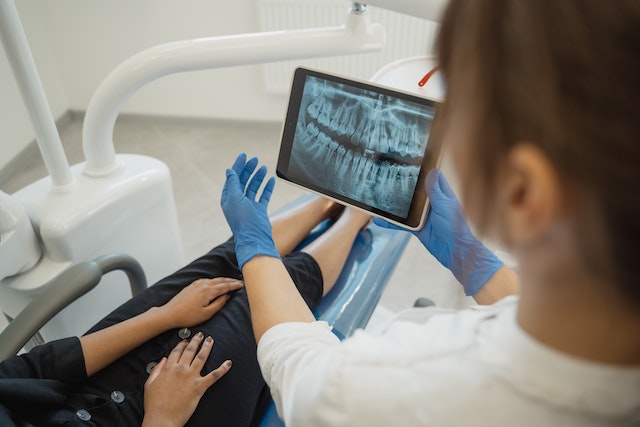Introduction:
Dental X-rays, also known as radiographs, play a crucial role in modern dentistry. They provide valuable diagnostic information that is often not visible during a regular dental examination. In this blog, we will explore the significance of dental X-rays in the diagnosis and treatment of oral health conditions. Understanding the benefits and safety measures associated with dental X-rays will help you make informed decisions regarding your dental care. Let’s delve into the details and discover the essential role dental X-rays play in oral healthcare.
1. Detecting Tooth Decay:
Dental X-rays are effective in detecting tooth decay, especially in areas not visible to the naked eye. They can reveal early signs of decay between teeth and beneath fillings, enabling dentists to address the issue before it progresses further.
2. Assessing Bone Loss:
X-rays are essential for evaluating bone density and detecting signs of bone loss caused by periodontal disease. This information helps dentists determine the severity of the condition and develop appropriate treatment plans.
3. Identifying Tooth and Jaw Abnormalities:
X-rays provide detailed images of teeth, roots, and the jawbone, allowing dentists to identify abnormalities such as impacted teeth, cysts, tumors, or jaw fractures. Early detection of these conditions is crucial for timely intervention.
4. Planning Orthodontic Treatment:
Dental X-rays aid in orthodontic treatment planning by providing a clear view of tooth positioning, jaw alignment, and eruption patterns. This helps orthodontists develop personalized treatment plans and make informed decisions regarding braces or other orthodontic appliances.
5. Assessing Sinus and TMJ Conditions:
Dental X-rays can assist in evaluating the sinuses and temporomandibular joint (TMJ) for conditions like sinusitis or TMJ disorders. This information helps dentists determine the cause of symptoms and develop appropriate treatment strategies.

6. Guiding Tooth Extraction:
X-rays are invaluable tools for guiding tooth extraction procedures. They provide a comprehensive view of the tooth roots, surrounding structures, and possible complications such as impacted wisdom teeth or root abnormalities. This helps dentists plan extractions with precision and minimize risks.
7. Monitoring Growth and Development:
For children and teenagers, dental X-rays are essential for monitoring dental and skeletal growth. They help dentists assess the eruption of permanent teeth, identify potential developmental issues, and intervene at the appropriate time.
8. Detecting Oral Infections:
X-rays can reveal infections such as abscesses or deep-rooted infections that are not visible externally. Early detection of these infections is crucial for preventing further complications and preserving oral health.
9. Evaluating Trauma and Injuries:
Following dental trauma or injuries, X-rays aid in assessing the extent of damage to teeth, roots, and surrounding structures. They provide valuable information for treatment planning and monitoring the healing process.
10. Planning Dental Implant Placement:
Dental X-rays are essential for evaluating bone density and structure when planning dental implant placement. They help determine the optimal location and angle for implant placement, ensuring the best possible outcomes.
11. Monitoring Oral Health Changes:
By comparing X-rays taken at different time points, dentists can monitor changes in oral health conditions such as gum disease or dental caries. This allows for early intervention and adjustment of treatment plans as needed.
12. Assessing the Success of Previous Treatments:
X-rays are valuable for assessing the success of previous dental treatments, such as root canals or fillings. They help dentists evaluate the effectiveness of the treatment and identify any potential complications or recurring issues.
13. Aid in Diagnosis of Systemic Conditions:
In some cases, dental X-rays may reveal signs of systemic conditions that manifest in the oral cavity, such as certain types of cancers or osteoporosis. Identifying these conditions early through dental X-rays can lead to timely referrals for further medical evaluation and treatment.

14. Improved Treatment Planning:
Dental X-rays provide dentists with a comprehensive view of the oral structures, allowing for precise treatment planning. They help determine the most appropriate treatment approach, select the right materials, and anticipate any potential challenges or complications.
15. Minimally Invasive Approach:
Dental X-rays assist dentists in adopting a minimally invasive approach to treatment. By providing a clear understanding of the problem, X-rays help dentists target specific areas, conserve healthy tooth structure, and perform precise interventions.
16. Patient Education and Engagement:
Visual aids like dental X-rays can enhance patient understanding and engagement in their own dental care. Dentists can explain the findings and treatment recommendations more effectively, empowering patients to make informed decisions about their oral health.
17. Safety Measures:
Modern dental X-ray equipment and techniques have significantly reduced radiation exposure. Dentists take precautions such as using lead aprons and thyroid collars to protect patients from unnecessary radiation. The benefits of dental X-rays far outweigh the minimal risks associated with radiation exposure.
18. Tailored Frequency of X-rays:
The frequency of dental X-rays depends on individual patient needs. Dentists consider factors such as age, oral health status, risk of dental disease, and medical history when determining the appropriate timing and frequency of X-ray examinations.
19. Advances in Digital Radiography:
Digital dental X-rays have revolutionized the field of dentistry. They offer immediate results, higher image quality, and the ability to enhance and manipulate images for more accurate diagnoses. Digital X-rays also reduce radiation exposure compared to traditional film X-rays.
20. Continual Advancements and Research:
The field of dental radiology is continuously evolving, with ongoing research and advancements in imaging technology. This ensures that dental professionals have access to the latest diagnostic tools and techniques, improving the accuracy and effectiveness of dental X-rays.
Conclusion:
Dental X-rays are essential diagnostic tools in dentistry, providing valuable information that assists in the diagnosis, treatment planning, and monitoring of oral health conditions. From detecting tooth decay and bone loss to guiding orthodontic treatment and evaluating oral infections, dental X-rays play a vital role in comprehensive dental care. With advancements in technology and safety measures, dental X-rays are safer and more accurate than ever before. Trust your dentist’s expertise in recommending and performing dental X-rays as needed, knowing that they are instrumental in maintaining your oral health and well-being.


